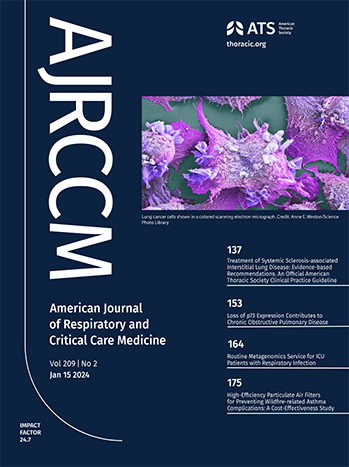Transmission of Bedaquiline-resistant Mycobacterium tuberculosis in KwaZulu-Natal, South Africa.
IF 19.4
1区 医学
Q1 CRITICAL CARE MEDICINE
American journal of respiratory and critical care medicine
Pub Date : 2025-09-30
DOI:10.1164/rccm.202506-1489oc
引用次数: 0
Abstract
RATIONALE Bedaquiline is a critical component of new drug-resistant tuberculosis (DR-TB) treatment regimens. Emergence of bedaquiline-resistant Mycobacterium tuberculosis (Mtb) threatens to undermine already limited treatment options. Understanding the evolution and transmission of bedaquiline-resistant strains is a high priority for TB control. OBJECTIVES We evaluated the prevalence, strain genetic diversity, and transmission of bedaquiline resistance among people with DR-TB. METHODS We conducted a prospective study of all patients diagnosed with TB resistant to a fluoroquinolone or a second-line injectable drug in KwaZulu-Natal province, South Africa, between 2018 and 2022. We utilized whole genome sequencing (WGS), SNP-based clustering, and Bayesian reconstruction of transmission trees to examine the genomic characteristics and transmission networks of bedaquiline-resistant Mtb strains. MEASUREMENTS AND MAIN RESULTS We enrolled 843 of 1070 eligible individuals and obtained WGS for 632 participants. Of the sequenced isolates, 14% (n=89) were genotypically bedaquiline-resistant, 67% (n=60) of which were in clusters of recently transmitted infections. Resistance was present across all Mtb lineages and across strains with different resistance profiles to other TB drugs. We observed no differences in lineage distribution, bedaquiline resistance-associated mutations, or drug resistance profiles between clustered and non-clustered isolates. Transmission inference and geographic reconstruction of transmission networks indicate considerable unsampled cases within transmission networks. CONCLUSIONS Bedaquiline resistance was common in this cohort of individuals with highly DR-TB. Most bedaquiline-resistant infections were attributable to recent transmission, involving Mtb strains with diverse genetic backgrounds and a variety of causative mutations. The diversity and transmissibility of bedaquiline-resistant Mtb signal a growing public health threat.南非夸祖鲁-纳塔尔省耐贝达喹啉结核分枝杆菌的传播。
RATIONALEBedaquiline是新型耐药结核病(DR-TB)治疗方案的重要组成部分。耐贝达喹啉结核分枝杆菌(Mtb)的出现有可能破坏本已有限的治疗方案。了解贝达喹啉耐药菌株的演变和传播是结核病控制的高度优先事项。目的评估耐药结核病人群中贝达喹啉耐药性的流行、菌株遗传多样性和传播情况。方法:我们对2018年至2022年在南非夸祖鲁-纳塔尔省诊断为氟喹诺酮类药物或二线注射药物耐药的所有结核病患者进行了一项前瞻性研究。利用全基因组测序(WGS)、基于snp的聚类和传播树的贝叶斯重建来研究耐贝达喹啉结核分枝杆菌菌株的基因组特征和传播网络。测量方法和主要结果我们从1070名符合条件的个体中招募了843名,并为632名参与者获得了WGS。在测序的分离株中,14% (n=89)为基因典型贝达喹啉耐药,67% (n=60)为新近传播感染的聚集性感染。耐药存在于所有结核分枝杆菌谱系和对其他结核药物具有不同耐药谱的菌株之间。我们观察到聚集性和非聚集性分离株在谱系分布、贝达喹啉耐药相关突变或耐药谱方面没有差异。输电推断和输电网络的地理重构表明,输电网络中存在大量未采样病例。结论贝达喹啉耐药在高耐药结核患者中普遍存在。大多数贝达喹啉耐药感染可归因于最近的传播,涉及具有不同遗传背景和各种致病突变的结核分枝杆菌菌株。耐贝达喹啉结核分枝杆菌的多样性和传播性标志着日益严重的公共卫生威胁。
本文章由计算机程序翻译,如有差异,请以英文原文为准。
求助全文
约1分钟内获得全文
求助全文
来源期刊
CiteScore
27.30
自引率
4.50%
发文量
1313
审稿时长
3-6 weeks
期刊介绍:
The American Journal of Respiratory and Critical Care Medicine focuses on human biology and disease, as well as animal studies that contribute to the understanding of pathophysiology and treatment of diseases that affect the respiratory system and critically ill patients. Papers that are solely or predominantly based in cell and molecular biology are published in the companion journal, the American Journal of Respiratory Cell and Molecular Biology. The Journal also seeks to publish clinical trials and outstanding review articles on areas of interest in several forms. The State-of-the-Art review is a treatise usually covering a broad field that brings bench research to the bedside. Shorter reviews are published as Critical Care Perspectives or Pulmonary Perspectives. These are generally focused on a more limited area and advance a concerted opinion about care for a specific process. Concise Clinical Reviews provide an evidence-based synthesis of the literature pertaining to topics of fundamental importance to the practice of pulmonary, critical care, and sleep medicine. Images providing advances or unusual contributions to the field are published as Images in Pulmonary, Critical Care, Sleep Medicine and the Sciences.
A recent trend and future direction of the Journal has been to include debates of a topical nature on issues of importance in pulmonary and critical care medicine and to the membership of the American Thoracic Society. Other recent changes have included encompassing works from the field of critical care medicine and the extension of the editorial governing of journal policy to colleagues outside of the United States of America. The focus and direction of the Journal is to establish an international forum for state-of-the-art respiratory and critical care medicine.

 求助内容:
求助内容: 应助结果提醒方式:
应助结果提醒方式:


